In Memorium
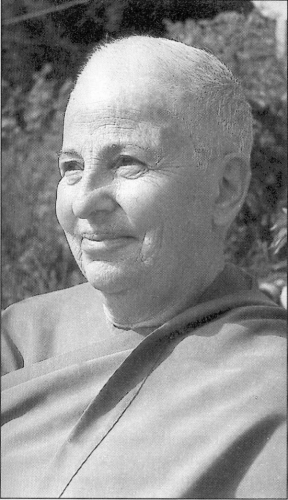
Being Nobody: Meditations on the Buddhist Path. She was ordained a Buddhist nun in Sri Lanka in 1979 and was one of the first pioneers to work on behalf of women in the dharma.
Born to Jewish parents in 1923, Ayya Khema lived in Berlin until she escaped to Scotland at the start of the war. Several years later she and her family, then living in Shanghai, were imprisoned in a Japanese prisoner-of-war camp, where she suffered the loss of her father. After the war, she traveled extensively throughout Asia, especially within Himalayan countries, and studied meditation.
She emigrated with her husband and their son and daughter to the United States in 1964 and subsequently began teaching meditation throughout the world. She established a Theravadin forest monastery, Wat Buddha Dhamma, near Sydney, Australia, in 1978. She also set up both the International Buddhist Women’s Center and the Parappuduwa Nun’s Island in Sri Lanka for women wanting to train intensively or to become ordained.
In 1987 she helped organize the first international conference of Buddhist nuns, where His Holiness the Dalai Lama gave the keynote speech. That same year, she became the first person to address the United Nations concerning Buddhism.
Ayya Khema was also the spiritual director of Buddha-Haus in Germany, founded in 1989, and just last year inaugurated the Order of the Western Forest Monastery Tradition, Germany’s first Buddhist forest monastery.
Which Came First?
Buddhists in Hong Kong have been deeply affected by the deaths of more than one million chickens, ducks, and geese that have occurred in the last few months. The poultry was slaughtered in an attempt to contain an avian strain of influenza “A” that was not known to infect humans until this year, when it killed four people and infected nine others. One hundred fifty Buddhist monks gathered in Kowloon to release 1,323 pounds of live fish into seas off Sai Kung as a symbol of life. “By releasing life back into the sea, it will be easier for animals and humans to come back into the world,” one Buddhist said.
Another seventy monks began a seven-day marathon chant before an elaborately adorned altar in Hong Kong’s New Territories to appease the dead birds. “The lives of these chickens are still lives,” Abbot Wing Sink said. “These chickens were humans before. Humans now could be chickens in later lives.”
Dog Days
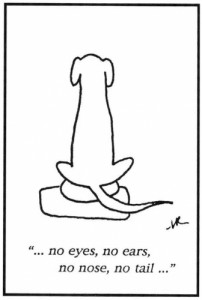
“I love the dogs, and I will never turn them down if they are brought to my temple,” Phra Sun thorn says. However, he admits that their rations have been diminished.
Monks Pipe Up
Protesting a multimillion-dollar oil pipeline, Buddhists monks ordained trees in the dense forests of southwestern Thailand near the Burmese border. Twenty chanting monks went into the jungle to first bless the trees and then adorn the trunks with saffron robes. “With ordination the trees will be sacred,” said Sor Sivalak, the main speaker at the protest rally.
The monks hope that the trees will be protected from the ecological devastation caused by the pipeline’s construction, which will also affect wildlife: “It will disturb a lot of species, especially elephants,” said Soraida Salwala, secretary-general of the Friends of the Asian Elephant foundation, who maintains that a salt lick running along the path of the pipeline is essential to the habitat of all mammals living in the 42-acre area. The pipeline is scheduled to be completed by July.
Last Rights
Thai families who can’t afford the cost of a funeral, which can be as high as $2,000 for a one-day service and $40,000 for a seven-day one, will receive aid from a new government program. Implemented by the Bangkok Metropolitan Administration and funded by wealthier citizens, this program will provide low-income families with a coffin, one-day prayer service, and cremation at one of forty designated Buddhist temples. This program is part of the Thai Chuay Thai (Thais Help Thais) scheme, initiated by a Buddhist monk last year, to help those less fortunate during the economic crisis.
The Tao of Diplomacy
China agreed to host a group of American religious leaders who plan to include a visit to Tibet. The delegation will travel to China between February 8 and March 1 and consists of Reverend Don Argue, president of the National Association of Evangelicals, Archbishop Theodore McCarrick of the Roman Catholic Archdiocese of Newark, New Jersey, and Rabbi Arthur Schier of Park East Synagogue in New York City. The United States team will look into allegations of Chinese oppression of Christians as well as the persecution of Tibetans. Two groups from the United States Congress will also visit Tibet in 1998 after having been denied access for more than five years. California Republican Representative Christopher Cox will travel with with both delegations, whose visits are scheduled for July and August.
State of the Union
A group calling themselves the All Burma Young Monks Union (ABYMU) claim that the military government, who renamed the country Myanmar, has executed three Buddhist monks and detained numerous others. The Union also maintains that 2,254 monasteries have been destroyed throughout Burma in recent months The ABYMU said that the military prohibited proper burial rites for the slain monks.
Myanmar’s State Peace and Development Council (SPDC) has prevented any discussions between the monks and the military from taking place. Monks were persecuted in Burma for their activism during the pro-democracy protests between 1988 and 1990.
Abroad at Home
Amnesty International and a human rights group known as the Appeal Movement Coordinating Council has charged that the Himalayan country of Bhutan is holding over one hundred people captive and that thousands of Bhutanese have been exiled from the country. The captives include monks and political prisoners who have been detained without trial. According to Amnesty International, those arrested were picked up on suspicion of belonging to or sympathizing with Druk National Congress, a pro-democracy organization.
The thousands of Bhutanese are living in exile in Nepal after being evicted from Bhutan. The refugees, who support the Bhutanese monarchy, are descendants of those Nepalese who came to Bhutan at the beginning of the century and who have been declared illegal immigrants under new Bhutanese cultural reforms.
A Bhutanese delegation led by Ratan Gazmere, secretary-general of the group representing the exiles, went to Kathmandu to discuss the plight of the refugees with Prime Minister Surya Bahadur Thapa in December. There have been seven attempts at diplomacy so far, but none have been successful.
In the Zone
Alongside Nike, Coca-Cola, and the usual corporate suspects, the monks at Zenkoji temple in Nagano, Japan, are serving as proud sponsors of the Winter Olympics. The monks will host CBS’s special events site during the telecast of the sports event. The official poster for the games continues the Buddhist theme: it features an ink drawing by Sesshu, a Zen monk of the medieval period. In contrast to the usual Olympian representations of athleticism, this year’s poster depicts a contemplative winter mountain scene.
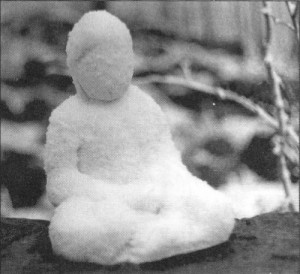
The Enthronement of Yangsi Dilgo Khyentse Rinpoche
Photographs by Martine Franck
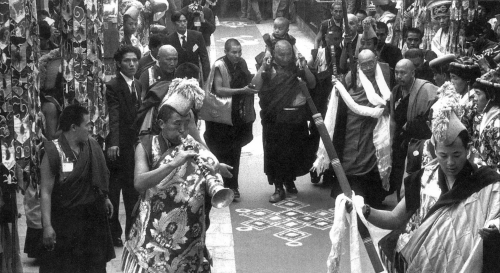
On December 5, 1997, at Shechen monastery in Nepal, a four-year-old boy named Ugyen Tendzin Jigme Landhrup was entroned as the reincarnation, or yangsi, of Dilgo Khyentse Rinpoche. Khyentse Rinpoche, who died in 1991 at the age of eighty-one, was one of the most revered Tibetan Buddhist masters of the century. Two years after his death, Ugyen was identified as his reincarnation. The ceremony took place before a crowd of fifteen thousand monks and laypeople, Tibetans, and Westerners. The Yangsi will live in the monastery and study with the disciples of Khyentse Rinpoche. In the photograph above, the Yangsi arrives for his enthronement on the shoulders of his “nanny,” Rigzin Trakpa; below, the boy makes fun of television crews during the ceremony.
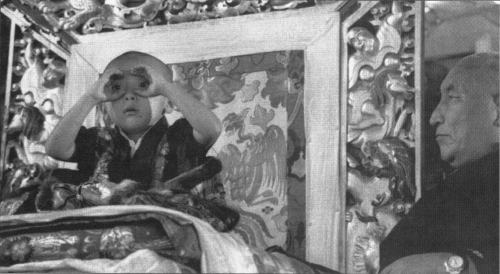
Day of the Dead
A Thai woman sprinkles perfumed water of a chedi, a Buddhist tower in the shape of a bell. This chedi was made of human skulls for a five-day religious ceremony at a cemetery in Samut Sakhon, thirty miles west of the capital, in preparation for what is believed to be the world’s largest cremation ever, held last December. The remains of 21,347 people, gathered over ten years by a voluntary foundation providing final rites to the unclaimed dead, were burned in the mass cremation.
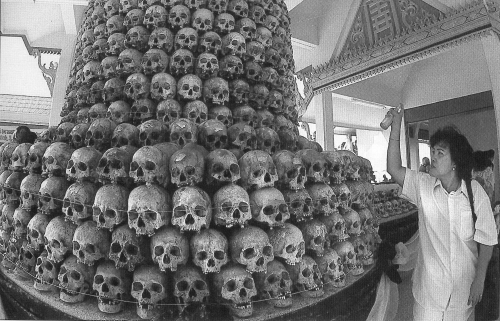
Thank you for subscribing to Tricycle! As a nonprofit, we depend on readers like you to keep Buddhist teachings and practices widely available.